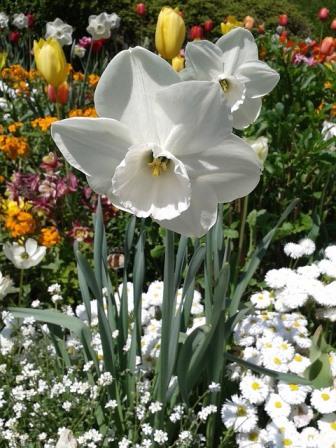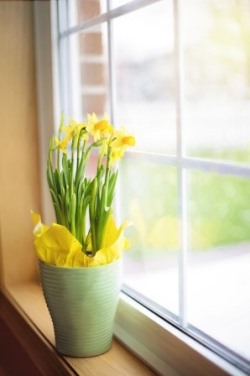In nature, daffodils thrive in the open sunny glades between the trees, just outside the drip line. You can create this same effect in your garden, underneath a single deciduous tree, or large woodlands of deciduous trees, by planting drifts of daffodils and over sowing with an evergreen shade lawn. Do not cut the grass but let it grow together with the daffodils to create a wild look.
 Daffodils grow well with other annualsVarious common names including daffodil, narcissus, and jonquil are used to describe all or some of the genus Narcissus. The Greek word “narcissus” means numbness; a reference to the toxic substance in its bulb, which is of a narcotic nature. Depending on which botanist you talk to, there is between 40 and 200 different daffodil species, subspecies or varieties of species, and over 25,000 registered cultivars divided among the thirteen divisions of the official classification system.
Daffodils grow well with other annualsVarious common names including daffodil, narcissus, and jonquil are used to describe all or some of the genus Narcissus. The Greek word “narcissus” means numbness; a reference to the toxic substance in its bulb, which is of a narcotic nature. Depending on which botanist you talk to, there is between 40 and 200 different daffodil species, subspecies or varieties of species, and over 25,000 registered cultivars divided among the thirteen divisions of the official classification system.
Narcissus is native to meadows and woods, with centres of distribution in the Western Mediterranean, southern Europe, North Africa and West Asia. Breeders have developed thousands of varieties; some with double, triple, or multiple rows and layers of segments; and in colours ranging from yellow to cream, and orange to pink and white. The enjoyment of these beauties can be extended by the planting of different varieties, with later-blooming cultivars succeeding earlier ones.
In the Garden & Home:
Daffodils mix well with small groundcovers and annuals for borders in semi-shade, as well as with shade loving bulbs like: Spring Starflower (Ipheion), Grape Hyacinth (Muscari), Snowflakes (Leucojum), Freesia and Garden Hyacinths.
They also grow beautifully in pots, and are often sold as indoor pot plants - ideal for a windowsill which receives morning sun. Spoil yourself with some daffodils, and even if you have the smallest of apartments, you are sure to have space for a bunch – Daffodils make excellent and long lasting cut flowers.
 Cultivation/Propagation:
Cultivation/Propagation:
Daffodils are extremely hardy to frost to and flourish in even the coldest climates. In South Africa they grow well throughout most of the cooler regions, as long as they are only planted out once the heat of summer has left the soil - usually towards the end of April. They will adapt to most well-drained garden soils but it is advisable to dig the beds over to a depth of at least 20cm, adding lots of compost and a dressing of bone meal.
Daffodils do best in dappled shade or full morning sun - in a position shielded from the brightest midday sun. It is vital that you water regularly from the time they are planted until they have completely died down in early summer; keeping the soil constantly moist but not soggy; mulching the soil will help to keep their roots cool and conserve moisture.
In the garden, plant the bulbs with about 5cm of soil above the neck of the bulb and about 10cm apart. In pots, pack them close together, almost touching, with just the barest covering of soil over the bulbs. Be patient, daffodils can take several weeks before showing themselves above the ground.
Cut out the dead flowers regularly and once the plant has finished blooming continue to water and feed the green leaves regularly, as this is when the nutrition they provide will feed the bulbs and produce a good flowering bulb for next season - only cut off the leaves once they are totally withered.
While some kinds of bulbs tend to dwindle and die out if left in the soil, daffodils should increase, and you can leave the bulbs in the soil for many years, provided the soil drains well. After four to five years well-fed bulbs will have formed many baby offsets and they will become overcrowded. You may lift them when their foliage starts to yellow, in early summer. Divide the offsets from the mother bulbs by prising them apart, and replanting immediately.
 Many gardeners prefer to lift their bulbs in early summer, storing them in a dry place, at ordinary room temperatures, until next autumn. If you have planted them in pots, the pots can be moved to a cool spot in summer, where they will not be overwatered, or you could bury the pots in the garden during summer, with just the rims showing.
Many gardeners prefer to lift their bulbs in early summer, storing them in a dry place, at ordinary room temperatures, until next autumn. If you have planted them in pots, the pots can be moved to a cool spot in summer, where they will not be overwatered, or you could bury the pots in the garden during summer, with just the rims showing.
Problems, Pests & Diseases:
Daffodils have few pest problems, but watch out for aphids, slugs and snails in spring.
Warning:
All parts of the daffodil are toxic. When swallowed, it can cause nausea, vomiting, diarrhoea, and abdominal pain. Eating the bulb can cause severe irritation of the mouth and stomach upset. These symptoms are usually not life threatening and resolve within a few hours.



 Daffodils never fail to charm, so spoil yourself with some - you’re worth it!
Daffodils never fail to charm, so spoil yourself with some - you’re worth it!